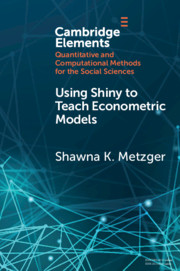
-
Select format
-
- Publisher:
- Cambridge University Press
- Publication date:
- 01 May 2021
- 20 May 2021
- ISBN:
- 9781108883993
- 9781108793407
- Dimensions:
- Weight & Pages:
- Dimensions:
- (229 x 152 mm)
- Weight & Pages:
- 0.19kg, 124 Pages
- Subjects:
- Research Methods in Politics, Politics and International Relations, Research Methods In Politics
- Series:
- Elements in Quantitative and Computational Methods for the Social Sciences
You may already have access via personal or institutional login- Subjects:
- Research Methods in Politics, Politics and International Relations, Research Methods In Politics
- Series:
- Elements in Quantitative and Computational Methods for the Social Sciences
Book description
This Element discusses how shiny, an R package, can help instructors teach quantitative methods more effectively by way of interactive web apps. The interactivity increases instructors' effectiveness by making students more active participants in the learning process, allowing them to engage with otherwise complex material in an accessible, dynamic way. The Element offers four detailed apps that cover two fundamental linear regression topics: estimation methods (least squares, maximum likelihood) and the classic linear regression assumptions. It includes a summary of what the apps can be used to demonstrate, detailed descriptions of the apps' full capabilities, vignettes from actual class use, and example activities. Two other apps pertain to a more advanced topic (LASSO), with similar supporting material. For instructors interested in modifying the apps, the Element also documents the main apps' general code structure, highlights some of the more likely modifications, and goes through what functions need to be amended.
References
Metrics
Altmetric attention score
Full text views
Full text views help Loading metrics...
Loading metrics...
* Views captured on Cambridge Core between #date#. This data will be updated every 24 hours.
Usage data cannot currently be displayed.
Accessibility standard: Unknown
Why this information is here
This section outlines the accessibility features of this content - including support for screen readers, full keyboard navigation and high-contrast display options. This may not be relevant for you.
Accessibility Information
Accessibility compliance for the PDF of this book is currently unknown and may be updated in the future.


